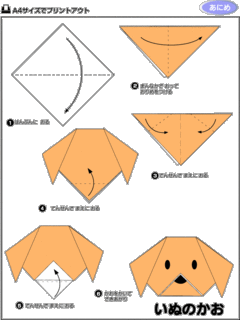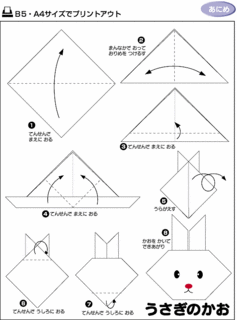Saturday, December 11, 2004
from :CapeCanaveral page's
Read this if you are a parent of a kid who would like to learn
origami...
...or if you are a kid who wonders why your art teacher thinks
origami is important.
I am writing from the perspective of an art teacher who likes to
exercise a child's brain; to stretch them out in directions that
could use a little flexibility so they build an awareness of
alternative ways of thinking, and to strengthen them in areas that
will serve them in regular academic tasks. Origami does all that in
an enjoyable way.
Kids don't give much verbal feedback to a teacher, but they have told
me they really like learning origami. They don't say it is easy, but
they do say they like it! I think that is one reason they do like
it...it does take concentration and care, it does take many steps, it
makes you feel like you have conquered something when you are done.
Best of all, you end up with a very cool model. This magic of turning
a flat piece of paper into a three dimensional sculpture is, perhaps,
the most enchanting feature of origami.
Kids feel "empowered"!
After all, if you can transform scrap paper into a jumping frog, you
have POWER! Parents often tell me that their daughter or son came
home and spent a week filling the house with a favorite model. Why do
you think kids do that? (Adults usually do one, or two to get it just
right, then stop until they need a gift for someone.)
The ability to visualize, to actually "see" in your head, a shape you
want to fold is a talent that can be strengthened with simple
practice. (Don't look for references to supporting research in this
draft of this essay...it's out there somewhere though!)
Have you ever heard the old story of the sculptor who was asked how
he knew what to carve? His answer was, "It's easy! I just see the
sculpture and take away what shouldn't be there...".
This talent is obviously useful to visual artists, but it is also of
the greatest use to our creative scientists and engineers. And, if
you are looking at this page on your computer monitor you know how
important graphics and visual methods for presenting information are
becoming. In fact, when analyzing huge amounts of data a graphic
interpretation is often the only way a person can really take in the
meaning, the pattern, quickly (or at all).
Origami is a relatively painless way to have kids realize the
importance of sequencing. Teachers spend a ton of time with some kids
because the child doesn't understand that some things have to be done
in a certain order of steps to be successful. Writing stories where
there is a beginning, middle and end may seem a simple concept...but
it isn't to lots of young people. The concept of "first things first"
has to be learned. If a child hasn't imprinted on the pattern of a
well built story, then they simply don't see the importance of
following a sequence of steps. Arithmetic relies on the first things
first stuff, too. The cool thing about origami is that I do not have
to tell a student that it their model isn't "right"; they can see
that they didn't get where they wanted to go (when your swan looks
more like a spit ball that isn't hard!)...and they back up and try
the sequence of steps with more respect and care on their own.
If you have kids you know that their ability to estimate the relative
size of things develops during grade school years. In math they have
to work on getting a feel for fractions. Half a pizza, a fourth of
the team, a third of our class and so forth are concepts that need to
become quickly and accurately understood. Origami is built of paper
folded to those fractions. "Exactly one half" has a more real feel to
it after a child sees what happens when you don't have it! (...the
small "half" of a candy bar holds the same lesson.) Basic geometry
concepts are painlessly learned (we very commonly have to bisect the
corner of a true square to form the two identical right
triangles....and having to cope with the knowledge that a "sort of"
square doesn't do this, or, even more basically, a square behaves
very differently than a rectangle, is tough on kids. By fifth grade
many kids who have had no personal reason for filing these facts away
are still clueless. True learning only occurs when kids feel that the
subject has importance to them in a direct and personal way. (It is
easier to see the need for learning multiplication if you are trying
to calculate the value of your very large trading card collection,
for another instance.)














